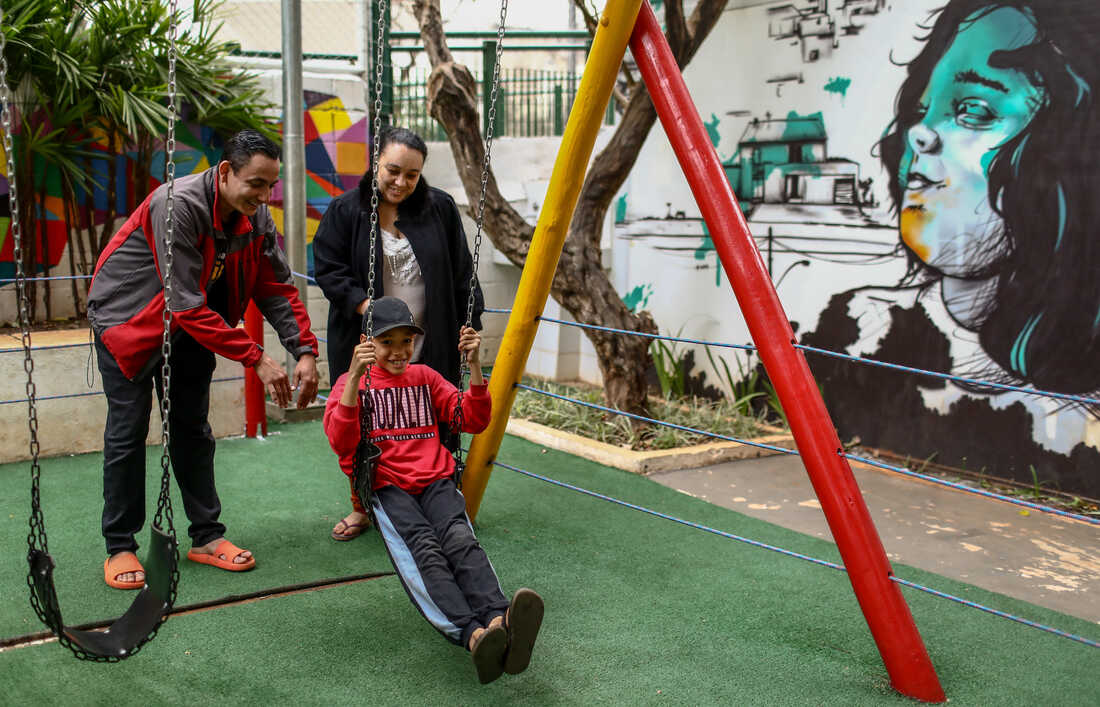
A tiny house gives them hope: How a homeless family in Brazil got a fresh start


Erica Lacerda de Souza, Bruce Lee Sousa and son Henrique of São Paulo, Brazil, lost their home during the pandemic but got a fresh start from a program that offers tiny houses to homeless people. At first they said no — it seemed too good to be true. Felipe Iruata for NPR hide caption
toggle caption
Felipe Iruata for NPR

Erica Lacerda de Souza, Bruce Lee Sousa and son Henrique of São Paulo, Brazil, lost their home during the pandemic but got a fresh start from a program that offers tiny houses to homeless people. At first they said no — it seemed too good to be true.
Felipe Iruata for NPR
“There was a morning when our son asked for a glass of milk and I knew I didn’t have any to give him,” says Erica Lacerda de Souza. “All we had left to eat in the house was rice and farinha [toasted manioc flour]. That’s not enough for a child.”
The 32-year-old Brazilian and her husband, Bruce Lee Sousa, 28, had already sold both of their cars and closed their bodega because of pandemic regulations when they sent their son Henrique, then 6 years old, to live with his maternal grandmother in the east end of São Paulo.
Bills were piling up and the couple’s other work — hers as a cleaner and his at a carwash — wasn’t enough. When the pandemic shut down the carwash where Lee Sousa worked too they lost the house they rented and almost everything in it.
With a few changes of clothes in a backpack and nowhere to go, the two ended up living at São Paulo’s downtown Barra Funda Terminal. They hoped sleeping on the floor of the busy station — a massive central hub for the city’s buses, subways and trains — would be safer than staying on the streets.
That was in July 2020.

The formerly homeless family in their tiny home. Slightly smaller than a one-car garage, it has enough space for a joint living and bedroom, a kitchenette with a fridge, a sink and two burners for cooking and a bathroom with a hot shower. The tiny house initiative is one way that São Paulo is trying to help the growing number of unhoused citizens. Felipe Iruata for NPR hide caption
toggle caption
Felipe Iruata for NPR

The formerly homeless family in their tiny home. Slightly smaller than a one-car garage, it has enough space for a joint living and bedroom, a kitchenette with a fridge, a sink and two burners for cooking and a bathroom with a hot shower. The tiny house initiative is one way that São Paulo is trying to help the growing number of unhoused citizens.
Felipe Iruata for NPR
Three years later, their life has had a remarkable turnaround. For the past six months, Lacerda de Souza and Lee Sousa have lived with their son in a tiny home. They’re one of 37 families in the Anhangabaú neighborhood to benefit from a new program in São Paulo called Vila Reencontro. It’s one of the ways this city of 12 million is trying to help its rising number of unhoused people — an estimated 53,000 in March of this year, up from 44,300 in 2019 and 48,600 last year.
The tiny houses of São Paulo are part of a global effort to address the critical issue of finding homes for those who, because of the pandemic and other economic factors, are among the more than 150 million unhoused people around the world.

A row of tiny houses in São Paulo — part of a municipal program in the center of the city that was inaugurated last year. Marco Storel for NPR hide caption
toggle caption
Marco Storel for NPR

A row of tiny houses in São Paulo — part of a municipal program in the center of the city that was inaugurated last year.
Marco Storel for NPR
Vila Reencontro is one of two programs in São Paulo that started during the pandemic to keep people housed as inflation and unemployment spiked. The other — called Morar Primeiro, or Live First — is fronted by housing nonprofit Fundo FICA and Father Julio Lancellotti, a Catholic priest known for his pioneering work with people who are unhoused. While both were inspired by the same philosophy and have similar goals, they take slightly different approaches to helping people get— and stay — off the streets.

The municipal government now operates two villas with a capacity of 160 people each and plans to open two more in the last half of August Marco Storel for NPR hide caption
toggle caption
Marco Storel for NPR

The municipal government now operates two villas with a capacity of 160 people each and plans to open two more in the last half of August
Marco Storel for NPR
Seeking solutions
Its shelters constantly overflowing, São Paulo wanted a program that would not only put a roof over people’s heads but also give them a fresh start.
It found inspiration in Housing First, a philosophy popularized by psychologist Sam Tsemberis and Pathways to Housing in New York in the 1990s. Its approach aims to quickly move people experiencing homelessness into independent and permanent housing while providing other needed services, like physical and mental health care and support in finding jobs.
With that in mind, the city created and funded Vila Reencontro and inaugurated its first community of tiny homes in December 2022. The municipal government now operates two villas with a capacity of 160 people each, and plans to open two more in the last half of August. The homes are meant to be transitional, allowing families to stay for up to 36 months. While there, they not only receive shelter and meals but also the support of other social services provided by the city.

Children play around Vila Reencontro — the project providing homes for the unhoused in São Paulo. The family interviewed by NPR was thrilled to have a safe place for their son to play. Marco Storel for NPR hide caption
toggle caption
Marco Storel for NPR

Children play around Vila Reencontro — the project providing homes for the unhoused in São Paulo. The family interviewed by NPR was thrilled to have a safe place for their son to play.
Marco Storel for NPR
For now, they’re giving priority to families with small children — some headed by women who have experienced domestic violence — and who have been unhoused for fewer than two years.
“More time on the streets means people create stronger ties to them,” says Tayná Silva, a spokeswoman for the Vila Reencontro program. “Those ties are difficult to break. Less time on the streets means they’re closer to autonomy, and the idea here is to promote autonomy.”
A haven after life in a bus terminal
Lacerda de Souza and Lee Sousa spent two weeks at Barra Funda Terminal. Other unhoused people living alongside them provided support, giving them cardboard so they didn’t have to sleep directly on the concrete floor and blankets so they wouldn’t be cold. Nonprofits came by with food, and nurses checked in to make sure nobody had any medical issues.
It was a nurse who helped get them out of the terminal. She was helping Lacerda de Souza manage the pain in her back caused by two herniated discs and told the couple about the city’s shelters. With her support, they found a shelter with beds available, but they were not happy that the sleeping quarters were separated by gender — and worried that what little they still had would be stolen.
During their six months at the shelter, they heard about a new pandemic program run by the city that allowed people without a home to live in “social hotels,” similar to shelters, with the exception that a family can stay together in a room of its own in an old hotel. They jumped at the chance to have their own space again and moved as quickly as they could.
Two months after they moved and when they were sure their new temporary home was safe, Henrique came to stay with them. But he struggled to adapt and cried at night, longing for his grandparents and the outdoor space he had at their home to play. In an attempt to help him adjust, they decided to let him go back-and-forth between his parents and grandparents, but they knew he needed a more stable environment.
That’s when Lacerda de Souza and Lee Sousa heard about Vila Reencontro.

The tiny houses of São Paulo are part of a global effort to address the critical issue of finding homes for those who, because of the pandemic and other economic factors, are among the more than 150 million unhoused people around the world. Marco Storel for NPR hide caption
toggle caption
Marco Storel for NPR
At just under 194 square feet — slightly smaller than a one-car garage — the tiny home where the family now lives gives them enough space for a joint living and bedroom, a kitchenette with a fridge, a sink and two burners for cooking and a bathroom with a hot shower. While a fully-equipped communal kitchen is still being built, families are served four meals a day — Brazilians add an afternoon coffee snack. A colorful playground sits at the center of the community, kept safe by security guards at its front gates.

Children play among the dwellings established for unhoused families. Marco Storel for NPR hide caption
toggle caption
Marco Storel for NPR
Can the government do more?
At Morar Primeiro, independence is also the goal, though they get there a bit differently. Instead of building tiny homes, the nonprofit purchases apartment buildings and houses where families can live. For the first six months the tenants are responsible for paying the water and electricity bills. In the next six months they add on 150 Brazilian reais ($31) in rent and in the second year 150 Brazilian reais ($31) in HOA fees. The idea is the tenants eventually take over all the bills and the place where they live becomes their permanent home.
The program started with 15 families who had been living under a viaduct and were being helped by Father Lancellotti. They hope to expand, but they argue the government needs to do more.
“The problem is we don’t have any support from public policies,” says Simone Gatti, architect, urbanist and president of Fundo FICA. “A lot of programs like these in other countries have that kind of support, but here we have nothing. We started this with volunteers and were only able to grow because of international partnerships we have and donations we’ve received.”
For Silvia Maria Schor, a housing policy specialist and coordinator of the São Paulo-based Center for Studies of People Experiencing Homelessness, programs like Vila Reencontro and Morar Primeiro are on the right track. There is no single solution for the wide variety of people who are unhoused, she says, so creating criteria — looking at which types of people most need a hand and who will best thrive because of it — to decide who to help first, like both programs have done, is crucial.
Policymakers also have a role, she says.
“Preventative policies are fundamental,” says Schor. “Don’t let them end up on the streets. Especially kids and teenagers. The streets wear them out. In five to seven years it becomes a chronic situation.”

Children watch TV at a facility for formerly homeless families in São Paulo. Marco Storel for NPR hide caption
toggle caption
Marco Storel for NPR
It seemed too good to be true
For Lacerda de Souza and Lee Sousa, Vila Reencontro is the beginning of a new chapter.
They were initially unsure of living in the tiny-house community, worried that it sounded too good to be true, and turned down the first offer they received to live there.
“They said we would have a fridge and a stove, and I thought, wait a minute,” says Lee Sousa. “Nothing is ever free. I was sure we would be handed a bill at some point and there would be no way to pay it.”
But they decided to take a chance when they heard Henrique would have a safe place to play.

When school is done for the day, 9-year-old Henrique enjoys playing at the playground at Vila Reencontro, a project that provides a home for those who’d lose their housing. “Here we’re in a villa with a number next to our door,” says his dad, Bruce Lee Sousa. “It’s a real address that we can give to people to come visit. It’s a real home.” Felipe Iruata for NPR hide caption
toggle caption
Felipe Iruata for NPR

When school is done for the day, 9-year-old Henrique enjoys playing at the playground at Vila Reencontro, a project that provides a home for those who’d lose their housing. “Here we’re in a villa with a number next to our door,” says his dad, Bruce Lee Sousa. “It’s a real address that we can give to people to come visit. It’s a real home.”
Felipe Iruata for NPR
Now, Lacerda de Souza doesn’t have to struggle with several flights of stairs she had to climb to their third-floor room at the social hotel, where she was often housebound because of the pain in her back. While meals are served daily at Vila Reencontro, she likes the freedom she now has to cook in her own home again.
As a pressure cooker full of corn-on-the-cob hisses on one of the two burners in the kitchenette, Henrique, now 9 years old, runs through the front door, out of breath and with a wide smile across his face. School is done for the day and he’s been playing at the playground with the other kids who live at Vila Reencontro.
Lee Sousa is now taking part in a work program and hopes to soon start a job with the city as a public health agent working with the unhoused. He eventually wants to go back to college to become a social worker. Lacerda de Souza wants to study again too, to become a psychologist.
They hope to be back on their feet in fewer than two years and to earn back everything they lost. Because of their tiny home, they say they have a sense of security and hope.
“Here we’re in a villa with a number next to our door,” says Lee Sousa. “It’s a real address that we can give to people to come visit. It’s a real home.”
Jill Langlois is an independent journalist based in São Paulo, Brazil. She has been freelancing from the largest city in the western hemisphere since 2010, writing and reporting for publications like National Geographic, The New York Times, The Guardian and Time. Her work focuses on human rights, the environment and the impact of socioeconomic issues on people’s lives.
Source: https://www.npr.org/sections/goatsandsoda/2023/08/13/1191832318/a-tiny-house-gives-them-hope-how-a-homeless-family-in-brazil-got-a-fresh-start
















